As an Amazon Associate I earn from qualifying purchases.
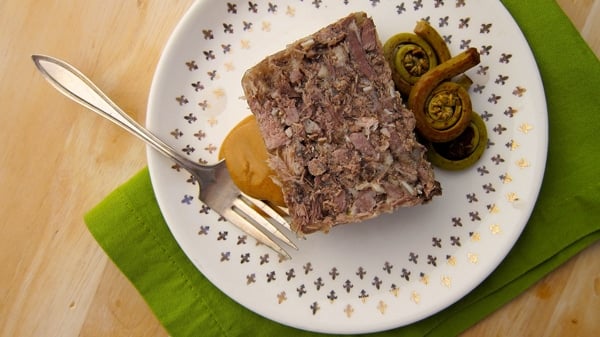
Why yes, this is a recipe for head cheese. But don’t you think the French fromage de tete sounds sooo much better?
A few years back I wrote about the Italian version of this lovely luncheon meat, coppa di testa. I love that recipe, but it requires an expensive beef casing to make, which you can only get mail order. I knew then that the easier way to make head cheese is to put it in a loaf pan. But for whatever reason I waited several years before doing this again, intending to make use of said loaf pan.
I also didn’t want to just re-do my old recipe, which works really well. So I decided to go the French route and make their version, fromage de tete. That version is always in some sort of pan, and I happen to own a pretty Le Creuset enameled terrine pan so it seemed like a natural. All I needed was a pig’s head.
That chance came after a successful hunt in Northern California. So I toted home the pig’s head along with everything else. On the drive I debated whether to make this recipe or to delve into the mysterious world of scrapple. The French won out this time, so scrapple will have to await my next pig’s head.
Once you have a wild pig’s head, your job has only begun. Now you need to skin it, which is always gnarly.
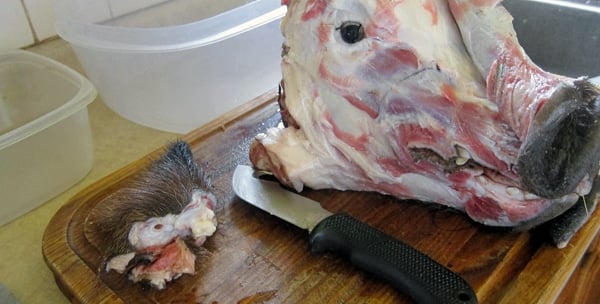
Yes, you could in theory scald the head and scrape all the hair off, but I shudder to think how unpleasant that task might be. I actually have an inkling, because I did just that with the ears. Why bother? Well, pig ears are pretty good eating once you clean and braise them, but I really needed the ears for the collagen in them: This helps set the fromage de tete.
Yeah, I could have gone and bought some pig feet, but I didn’t feel like it.
When it was all said and done, I have to say this is a damn good head cheese. I am often pretty put off by some versions, which rely heavily on an iron-like gelatin to hold them together. There is a certain rubberiness to these versions of head cheese (many of them German) that I just can’t abide by.
This version, however, is really close to a rough country pate: The collagen certainly holds it together well, but it’s not really very noticeable. What you notice is a richness, a silkiness and a meatiness. Despite all the herbs and spices in this recipe, you really don’t pick up on them too much, although you would notice their absence.
My fromage de tete is a meat bomb, though, make no mistake. Just like my English duck pie, it’s tough to eat a whole slice without the aid of either mustard or horseradish and a few pickled things alongside. Combined, though, it’s perfect.
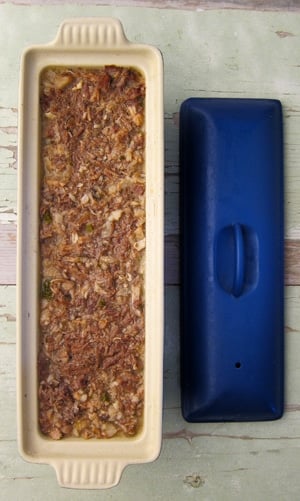
For spices, I use a very French spice mix inspired by one I read in the great Jane Grigson’s book, Charcuterie and French Pork Cookery. Feel free to alter your spice mix to suit yourself. For this recipe, however, it is pretty important to have the French quatre epices. You can find it in good supermarkets (the link takes you to an online source), or you can approximate your own by mixing:
- 1 1/2 teaspoons white pepper
- 1/2 teaspoon allspice
- 1/2 teaspoon clove
- 1/2 teaspoon nutmeg
- 1 teaspoon ground ginger
And yes, I know that’s more than four. Blame the French.
French Head Cheese, Fromage de Tete
Ingredients
- 1 pig's head, skin on or off is fine, including ears
- 4 bay leaves
- 1 tablespoon cracked black peppercorns
- 8 to 10 allspice berries, cracked
- 8 to 16 juniper berries, crushed (optional)
- 1 tablespoon dried thyme
- 2 carrots, chopped
- 2 celery stalks, chopped
- 1 large onion, chopped
- 3 star anise, optional
- 1/2 cup red wine vinegar
- 1 cup wine, any kind will do
- Salt
- 1 tablespoon French quatre epices
Instructions
- Once your pig head has been skinned, or is otherwise ready, put it in a large pot and cover with cool water. Add the ears if you have them, or a pig's foot or two; you want these appendages because they add a lot of collagen to the broth, which helps everything set later. Turn the heat to medium-high, cover the pot and bring it to a simmer. Skim any scum that floats to the surface, then add all the herbs and spices and vegetables. Pour in the vinegar, too. Simmer this very gently -- the surface should just shimmy rather than boil -- until the head basically falls apart. Definitely 3 hours, and probably closer to 5 or 6.
- Now you have the awesomely fun job of picking everything off this dead pig's head. It's actually kind of a pleasant surprise to see how much actual meat is on the thing, but remember you also want fat and some cartilaginous bits, too. My rule: The weirder it looks, the smaller it gets chopped. Cheeks and other bits of meat I chop rather roughly, and the tongue -- after it's been peeled, of course -- gets cut into the largest pieces of all.
- I generally toss stringy tendons, the eyeballs (although the fat behind the eye is awesome), the palate, and any random bits I can't really identify.
- Put all this in a bowl and add the quatre epices. Mix well and turn your attention to the broth.
- Take about a quart of the broth, strain it and put it into a pot with the wine. I used vermouth here, as this is a French fromage du tete. Boil the crap out of it until the liquid reduces by a little less than half.
- Put all the meat and such into the pot. Now you add salt -- finally, right? You may need a solid tablespoon, but start small. Taste the mixture: You want it to be a little salty and slightly acidic. Add some more red wine vinegar if you want to; I added about 2 tablespoons. Simmer gently for another 15 minutes. This infuses all the yummy bits with the collagen-rich broth.
- Remove all the yummy bits with a slotted spoon and pack into a loaf pan or terrine pan. Make sure it's nice and even in the pan. Pour enough of the reduced broth to fill any crevices in the fromage, plus enough to pool just a little on the top of the meat. Now cover the fromage and let it chill in the fridge overnight to set.
- Eat with mustard and pickled things. Sauerkraut and bread are good combinations, too, if you want to be more Germanic -- remember Alsace-Lorraine is basically a hybrid of the two countries if you are worried about feeling authentic. Covered, the fromage will keep for a week to 10 days. It does not freeze well, however.
Notes
Nutrition
Nutrition information is automatically calculated, so should only be used as an approximation.
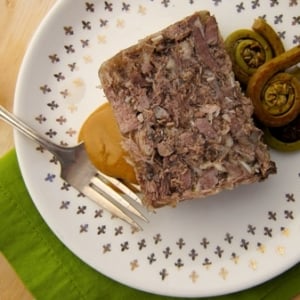

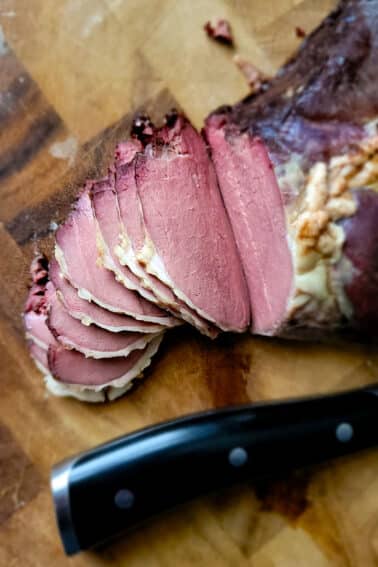
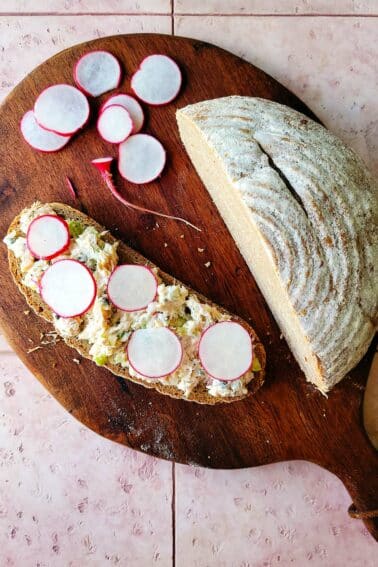

Works well with Javelina also – and you end up with a beautifully cleaned skull.
I used this recipe with 4 sheep heads, everything turned out great. I like aggressive spices so I doubled the ratio of quatre epices and added a little Calabrian chili as well. Tasting as you mix is a must. Just finished making a batch with pig heads, waiting for it to cool. Thanks for posting this recipe!
I love this recipe and tried it for our Halloween dinner party, adding a pig trotter for extra collagen. It was very well received, accompanied by a tangy sauce ravigote. So much so that I wrote about a blog post about it, linking back to your recipe. I hope you don’t mind me sharing!
Any suggestions or alterations for using a bear head?
Heather: Fascinating! Let me know how it turns out. Only thing I might add would be a couple pig’s feet for extra collagen. You can get them at Latin or Asian markets.
I got a cow elk last Saturday. I really want to try a fromage with her head. However, I’m guessing the head probably weighs over 20lbs (best guess is 25lbs, without putting it on a scale). Whatever it weighs that head is significantly larger than a boar’s head. How, approximately, should I scale up the rest of the ingredients to keep it in proportion?
I’m making scrapple (or pon haus as we called it in WV) this weekend. My neighbor is a custom meat cutter and he brought me a meaty head, scrap bones, 2 hearts and a liver. I make my pon haus PA Dutch style, boil the meat, strain the broth, grind the good bits, then back into the broth and add buckwheat flour, cornmeal, salt and pepper to taste and cook until porridge. Maybe a little sage but not too much. I used to butcher with my old neighbors in WV- 10-14 hogs a year. We always head 3 big iron kettles going.. One for lard and cracklins, one for pon haus and one for wash water.
Good times..
I’m 78 years old and when I was a kid my mother used to make this with a whole hog’s head bought directly at the farm in the fall. Today I make my own using 3 lbs of boneless pork shoulder and 2 lbs of pork hocks using the same recipe and the same spices. Maybe not as good as my mother’s, but a very good substitute.
I have never tried head cheese before, but I think that fromage makes it sound a lot more palatable.
Cool, I might have to give that a try. Thanks for the reply. I’ll be interesting in getting your take on the seasoning when you post it up.
Jake
Jake: I experimented with it last season and will post up what I find this season, which just started. Basically you’d toss 4-6 salmon heads in a pot, along with the racks and fins (no gills, though!) and simmer. Collagen is in the head — there’s LOTS of it. Don’t skin the heads.
Hi Hank,
You mentioned in your post about doing this with other game animals. I can see this recipe extending to a lot of big game very well. However, you also mentioned doing it with fish such as salmon. I go through quite a bit of salmon every year and I would like to try this but I am not sure what the process would be. Any chance you can provide some details on how you would do that? Where would the collagen come from? Would you attempt to skin the salmon heads, or not bother? It seems like more of the salmon could be used after taking the fillets off as well in order to get more meat.
Thanks!
Jake
Hank: Well, if something is going to weird people out more than ‘headcheese’ it would probably be ‘foot cheese’
I also love pig’s ears. Chinese restaurants and barbeque shops blanch the ears, then slice thinly (a meat slicer set to produce translucent slices would be ideal) and marinate them as a snack or appetizer. Sesame and chili oil with shredded green onions is my personal favourite.
Wow, that looks fantastic Hank! If we were closer, I would gladly trade you some home made scrapple for some French head cheese. We butcher hogs the third weekend of December with friends who are farmers every year. We are not ‘back woods folk’. I work in Baltimore and live in a neighborhood in a small town. I say this, because this is something just about anyone can learn to do with some commitment and training, like field dressing and processing your own game. They have a large tub that we heat water in and then add lye and wood stove ash. The water is hot enough to scald the hogs, but not hot enough to peel the skin. After a few dunks, the hair scrapes off pretty easily. Then we hang them from tripods made of small cut trees in the yard, finish scraping them and remove the heads. We make scrapple because that is what they have been making for fifty years, but I would love to try making head cheese using your recipe. To make the scrapple we separate the lower jaws and remove the head meat from the skull like you did. We still have the skin which is laden with fat, and this contributes to the velvety texture of the finished product. The head meat, jaws, and skulls along with the kidneys, livers, and spleens go into a large cauldrons of hot water to cook. When they are done we remove them from the cauldron, cut everything from the bone, and run it through a meat grinder with a coarse grind. Then it all goes back into the cauldrons with flour, salt, pepper, and cornmeal. Five hogs makes about 60 gallons of scrapple! This gets divided between everyone helping. We do everything ourselves and waste little. It takes a weekend and about twelve to fifteen of us to fully process five hogs including making sausage. It’s definitely an old school event and I am grateful to be a part of it. Your recipe makes me want to call my local butcher and get a hog head!
My most recent pigs head went into posole, but this is just the recipe I’ve been waiting for for the next one; it looks awsome and my mouth is watering just thinking of it with cornichons and mustard! A couple of quick questions – after cooking the head the broth contains quite a lot of fat, but you didn’t chill it and remove this, correct? Just reduced it with the fat? Second, there’s no need to press the mixture in the terrine pan with a weight while it’s chilling? I guess the collagen and perhaps all the fat (?) keep it together without this? Thanks for the recipe; I hope mine tastes as good as yours looks!
This recipe is very similar to one that we have in Portugal called Cabeça de Xara. I sent you the recipe – its in portuguese but you see some pictures: https://outrascomidas.blogspot.pt/2009/11/cabeca-de-xara.html. Greetings from Portugal,
Sergio Charneco
Chanman: I suppose, but then it would be fromage du pied du cochon… 😉
Jamie: Yep, they are pickled. Recipe to come soon.
I have a pigs head in the freezer and will be trying this recipe tomorrow, it looks amazing as always. Are those fiddleheads pickled? Is there a national Headcheese council that we could petition to officially change the name of headcheese to something more pleasant. I have made headcheese dozens of times over the years and many people won’t even try it just because of the name. But you put Fromage du tete on a charcuterie plate and everybody loves it.
The recipe looks absolutely delicious; I love the spice combo. I don’t particular like the photo of the carved head, but I’ll ignore that. The only time I ever heard of “head cheese” was in reading Little House in the Big Woods by Laura Ingalls Wilder. There is a chapter on butchering the pig, and she describes making the head cheese.
I’m not sure if I’m adventurous enough to try this, but after doing several boiled European mounts of deer, it doesn’t seem all that foreign to simmer down a big game skull. With a buck you could cut out skull plate and simmer the remains in a small pot. I’ve also seen many a modified turkey fryer set up to simmer the head, antlers and all. That’s what I’ve done before.
Picking all the meat off is part of the process anyway, so making head cheese would mean using all the bits I normally throw away.
For those of us working without a pig’s head, would trotters and hocks work instead?